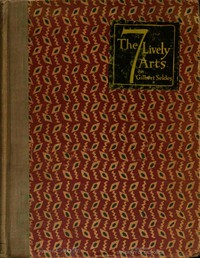The Seven Lively Arts by Gilbert Seldes
"The Seven Lively Arts" by Gilbert Seldes is a critical examination of various forms of American entertainment written in the early 20th century. The text explores how these lively arts, including vaudeville and film, were often dismissed by the cultural elite, yet they uniquely captured and reflected the spirit of their time. Through an affectionate lens, Seldes argues for their significance and artistic value, featuring noteworthy figures such as Charlie Chaplin. The
opening of the book sets the tone for Seldes' exploration by addressing slapstick comedy and its place in American culture. He reflects on the origins and evolution of the Keystone comedies, emphasizing their distinctive charm and vitality despite critical neglect. Seldes acknowledges the influence of great comedic artists, particularly Mack Sennett and Chaplin, while critiquing the broader societal perceptions of comedy as a vulgar or unrefined art form. Through an insightful narrative, he positions slapstick and its creators within the larger artistic landscape of American culture, advocating for a deeper appreciation of the genre. (This is an automatically generated summary.)
Read or download for free
| How to read | Url | Size | |||
|---|---|---|---|---|---|
| Read now! | https://www.gutenberg.org/ebooks/66294.html.images | 615 kB | |||
| EPUB3 (E-readers incl. Send-to-Kindle) | https://www.gutenberg.org/ebooks/66294.epub3.images | 4.3 MB | |||
| EPUB (older E-readers) | https://www.gutenberg.org/ebooks/66294.epub.images | 4.3 MB | |||
| EPUB (no images, older E-readers) | https://www.gutenberg.org/ebooks/66294.epub.noimages | 458 kB | |||
| Kindle | https://www.gutenberg.org/ebooks/66294.kf8.images | 6.2 MB | |||
| older Kindles | https://www.gutenberg.org/ebooks/66294.kindle.images | 6.1 MB | |||
| Plain Text UTF-8 | https://www.gutenberg.org/ebooks/66294.txt.utf-8 | 513 kB | |||
| Download HTML (zip) | https://www.gutenberg.org/cache/epub/66294/pg66294-h.zip | 5.1 MB | |||
| There may be more files related to this item. | |||||
Similar Books
About this eBook
| Author | Seldes, Gilbert, 1893-1970 |
|---|---|
| LoC No. | 24009374 |
| Title | The Seven Lively Arts |
| Alternate Title | The 7 Lively Arts |
| Contents | The keystone the builders rejected -- "I am here to-day": Charlie Chaplin -- Say it with music -- Tearing a passion to ragtime -- Toujours jazz -- Mr. Dooley, meet Mr. Lardner -- A tribute to Florenz Ziegfeld -- The Darktown Strutters on Broadway -- Plan for a lyric theatre in America -- The one-man show -- The dæmonic in the American theatre -- These, too -- The "vulgar" comic strip -- The Krazy Kat that walks by himself -- The damned effrontery of the two-a-day -- They call it dancing -- St. Simeon stylites -- Burlesque, circus, clowns, and acrobats -- The true and inimitable kings of laughter -- The great god bogus -- An open letter to the movie magnates -- Before a picture by Picasso -- Appendices: Appendix to "I am here today". "Bananas" and other songs. Appendix to These, too..." The Krazy Kat ballet. Further note on the Fratellini. The cinema novel. Acknowledgments. |
| Credits | Tim Lindell, Charlie Howard, and the Online Distributed Proofreading Team at https://www.pgdp.net (This book was produced from images made available by the HathiTrust Digital Library.) |
| Reading Level | Reading ease score: 62.8 (8th & 9th grade). Neither easy nor difficult to read. |
| Language | English |
| LoC Class | PN: Language and Literatures: Literature: General, Criticism, Collections |
| Subject | American wit and humor |
| Subject | Motion pictures |
| Subject | Music -- History and criticism |
| Subject | Theater -- United States |
| Subject | Dance |
| Subject | Journalism |
| Subject | American wit and humor, Pictorial |
| Subject | Circus |
| Category | Text |
| EBook-No. | 66294 |
| Release Date | Sep 13, 2021 |
| Most Recently Updated | Oct 13, 2022 |
| Copyright Status | Public domain in the USA. |
| Downloads | 528 downloads in the last 30 days. |
| Project Gutenberg eBooks are always free! | |

